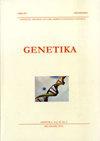利用SSR标记评价黄瓜(Cucumis sativus L.) F1和F2群体的遗传纯度和早熟性
4区 农林科学
Q3 Agricultural and Biological Sciences
引用次数: 0
摘要
利用SSR (Simple Sequence Repeat)标记对黄瓜(Cucumis sativus L.) F1和F2群体的遗传纯度和早熟性进行了评价。实验于2015年和2016年在喜马偕尔邦索兰瑙尼的Yashwant Singh Parmar博士园艺和林业大学蔬菜科学系的实验研究农场进行。研究中使用的实验材料包括kira -75和PI-618860, kira -75是一种生长在喜马偕尔邦(Himachal Pradesh)低山丘和中山的商业品种,开花晚,基因型PI-618860是一种从美国中北部地区植物引种站收集的自交系,开花早,耐各种生物胁迫。为评价遗传纯度和早熟性,将亲本Khira-75与PI-618860杂交,饲养F1和F2群体。遗传纯度研究表明,一个标记csn160在亲本和群体中均有分离。此外,利用ssr262和SSR17922两种共显性标记对F2群体进行早期评分显示了令人满意的结果,这些标记在亲本和群体中分离,与观察到的表型相关。本文章由计算机程序翻译,如有差异,请以英文原文为准。
Assessment of genetic purity and earliness in F1 and F2 population of cucumber (Cucumis sativus L.) using SSR markers
Simple Sequence Repeat (SSR) markers were used to assess the genetic purity and earliness in F1 and F2 population of cucumber (Cucumis sativus L.) respectively. Experiment was carried out at the Experimental Research Farm of the Department of Vegetable Science, Dr Yashwant Singh Parmar University of Horticulture and Forestry, Nauni, Solan, Himachal Pradesh (HP) during the years 2015 and 2016. Experimental material used in the study comprised of Khira-75, a commercial variety grown in low and mid hills of the state (Himachal Pradesh) which is late in flowering and genotype PI-618860, an inbred line collected from North Central Regional Plant Introduction Station, USA which is early in flowering and tolerates various biotic stresses. For assessment of genetic purity and earliness the parents Khira-75 and PI-618860 were crossed and F1 and F2 population were raised. Genetic purity studies revealed that one marker CSN 160 was observed to be segregating in the parents as well as the population. Further, scoring of earliness in F2 population revealed promising results using 2 co-dominant SSR00262 and SSR17922 markers, which segregated in the parents and population in correlation with the observed phenotypes.
求助全文
通过发布文献求助,成功后即可免费获取论文全文。
去求助
来源期刊

Genetika-Belgrade
AGRONOMY-GENETICS & HEREDITY
CiteScore
1.80
自引率
0.00%
发文量
1
审稿时长
6-12 weeks
期刊介绍:
The GENETIKA is dedicated to genetic studies of all organisms including genetics of microorganisms, plant genetics, animal genetics, human genetics, molecular genetics, genomics, functional genomics, plant and animal breeding, population and evolutionary genetics, mutagenesis and genotoxicology and biotechnology.
 求助内容:
求助内容: 应助结果提醒方式:
应助结果提醒方式:


